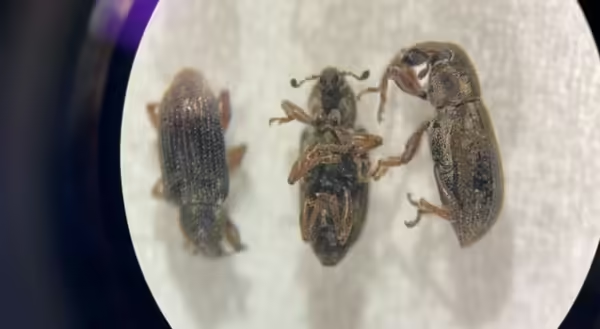
Infestations of the domestic turf pest, annual bluegrass weevil (ABW), Listronotus maculicollis, have officially been identified in Northern Illinois. Historically, this insect has been a pest in highly managed turf in Mid-Atlantic states and has recently been infesting new states throughout the Midwest. In 2023, ABW infestations were identified in Illinois for the first time in two North Chicago golf courses. Since then, the infestations have increased to 10 golf courses in the greater North Chicago area. Low levels of ABW may have existed in Illinois before 2023, as symptoms can be mistaken for several other issues such as anthracnose, localized dry spot, and wilt. Quick identification will be vital in the coming years to formulate a proper response for this hard-to-identify pest.
Injury and where this pest is found
ABW is primarily a pest in short-cut annual bluegrass (Poa annua) and can also be found feeding on creeping bentgrass (Agrostis stolonifera). The insect is considered a pest only in highly managed turf such as golf courses and sports turfs that contain annual bluegrass and is not considered a pest in managed turf that only contains creeping bentgrass. Home lawns containing annual bluegrass are not under threat of receiving damaging levels of ABW injury due to the difference in turf management practices.
ABW larvae and adults feed on the stems and crowns of annual bluegrass leading to a weakened root system and plant death. Damage is most commonly seen in golf course collars, fairways, and tee boxes but is capable of causing damage to greens. The beetle overwinters in field edges as adults with multiple generations per year. This allows them to reach damaging levels earlier than many other turf issues and sustain damaging levels throughout the summer. As the summer continues and the heat increases, symptoms can worsen due to the injured root system, even if populations have been effectively controlled or dipped naturally.
Monitoring
A monitoring program should be considered for courses in the north Chicago area to prevent potential ABW damage. Adults are small with mottled dark coloring and a long snout. Monitoring can begin for adults in May using water and soap flushes using 1 fluid oz of lemon dish soap for 1 gallon of water and poured over a 1 square foot area. ABW larvae are cream-colored, with a brown or orange head capsule. Larvae can be monitored throughout the summer through cores. Turf cores should be cut into quarters and submerged in saline solution for an hour, or placed under a heating lamp and set over a funnel and soapy water for 2 days.
Controls
When infestations do arise, insecticide treatments can help prevent damage to highly managed turf. The organophosphate acephate and pyrethroids such as bifenthrin can be used to kill adults in the spring before eggs are laid. This type of treatment will be best in locations where ABW infestations have already been identified or where good monitoring programs have been established. Larva can be controlled using clothianidin (neonicotinoid), spinosad (spinosyn), and cyantraniliprole and tetraniliprole (anthranilic diamide). Pyrethroid resistance has been an issue in eastern populations, and all insecticides should be rotated to prevent further resistance issues.
References and additional resources:
McGraw, B. (2022, May 5). Annual Bluegrass Weevil. Penn State Extension, Penn State Extension. extension.psu.edu/annual-bluegrass-weevil.
Rice, Henry., Wu, S. (2024, January 29) Annual Bluegrass Weevil. Ohioline, Ohio State University Extension. ohioline.osu.edu/factsheet/ent-0095.
Settle, D., and Singh, S. (2023, August 25). 100 Degrees! Annual Bluegrass Weevil, Pythium Blight, and Fairway Research. Medium, CDGA Turfgrass Program. turfresearch.medium.com/100-degrees-annual-bluegrass-weevil-pythium-blight-and-fairway-research-83e85690ebe3.

Special thanks to Derek Settle of the CDGA turfgrass program and Ben McGraw of Penn State for their assistance with this article.
Photo credits:
Top Right - Adult annual bluegrass weevil (Listronotus maculicolliss), Shannon Bradley, Virginia Tech.
Below Right - Adult annual bluegrass weevil found during monitoring, Shannon Bradley, Virginia Tech.
ABOUT THE AUTHOR: John Schepis provides subject matter expertise and training in pesticide safety with an emphasis on entomology.